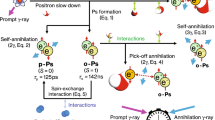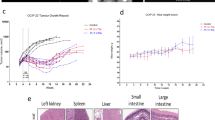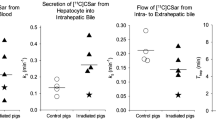Abstract
Nitroimidazole markers of tumour hypoxia bind to normoxic liver and the question has been raised whether this is due to low oxygen concentration or microregional activity of specialised nitroreductases. To answer this question, the binding patterns of the 2-nitroimidazole, pimonidazole, were compared following perfusion of surgically isolated rat livers in anterograde and retrograde directions. Perfusion at low flow rates in anterograde or retrograde directions can be used intentionally to alter oxygen gradients without altering enzyme distributions. Perfusion by means of the portal vein (anterograde direction) produced pimonidazole binding in the pericentral region of liver similar to that observed for pimonidazole binding in vivo. A complete reversal of this binding pattern occurred when the isolated liver was perfused by way of the central vein (retrograde direction). In this case, pimonidazole binding occurred in the periportal region. The extent and intensity of binding in the periportal region during perfusion in the retrograde direction was similar to that in the pericentral region during perfusion in the anterograde direction. It is concluded that low oxygen concentration rather than the non-homogeneous distribution of nitroreductase activity is the primary determinant of 2-nitroimidazole binding in liver.
This is a preview of subscription content, access via your institution
Access options
Subscribe to this journal
Receive 24 print issues and online access
$259.00 per year
only $10.79 per issue
Buy this article
- Purchase on Springer Link
- Instant access to full article PDF
Prices may be subject to local taxes which are calculated during checkout
Similar content being viewed by others
Author information
Authors and Affiliations
Rights and permissions
About this article
Cite this article
Arteel, G., Thurman, R., Yates, J. et al. Evidence that hypoxia markers detect oxygen gradients in liver: pimonidazole and retrograde perfusion of rat liver. Br J Cancer 72, 889–895 (1995). https://doi.org/10.1038/bjc.1995.429
Issue Date:
DOI: https://doi.org/10.1038/bjc.1995.429
This article is cited by
-
Transiently hypoxic tumour cell turnover and radiation sensitivity in human tumour xenografts
British Journal of Cancer (2022)
-
HIF activation enhances FcγRIIb expression on mononuclear phagocytes impeding tumor targeting antibody immunotherapy
Journal of Experimental & Clinical Cancer Research (2022)
-
In vivo O2 imaging in hepatic tissues by phosphorescence lifetime imaging microscopy using Ir(III) complexes as intracellular probes
Scientific Reports (2020)
-
Control and dysregulation of redox signalling in the gastrointestinal tract
Nature Reviews Gastroenterology & Hepatology (2019)
-
Oxygen Mapping of Melanoma Spheroids using Small Molecule Platinum Probe and Phosphorescence Lifetime Imaging Microscopy
Scientific Reports (2017)



